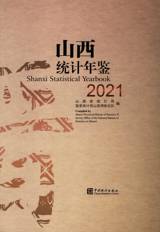一、《山西统计年鉴-2021》收录了全省和各地市、县(市、区)、有关部门2020年经济、社会、科技等方面的统计数据,以及多个重要历史年份主要统计数据,是一部全面反映山西省国民经济和社会发展情况的资料性年刊。为便于国际交流,内文全部采用中英文对照。 二、全书共分20个篇章:1.综合;2.人口、劳动工资和社会保障;3.物价;4.人民生活;5.财政、金融和保险;6.能源;7.固定资产投资;8.对外经济贸易;9.农业;10.工业;11.建筑业;12.房地产;13.批发和零售业;14.住宿、餐饮业和旅游;15.交通运输、邮电通信业;16.教育、科技;17.文化、体育、卫生、环保;18.城市概况;19.地市篇;20.县(市、区)篇。为方便读者使用,各篇章前绘制了反映总体趋势的统计图,篇末附有《主要统计指标解释》,对主要统计指标的涵义、统计范围和统计方法以及历史沿革予以简要说明。 三、与《山西统计年鉴-2020》相比,本年鉴内容主要做了如下修订:“综合”篇,修订了人均地区生产总值历史数据;“人口、劳动工资和社会保障”篇,根据第七次全国人口普查结果,对人口与就业相关历史数据作了修订,并调整了相关指标;“固定资产投资”篇,删减了房屋建筑面积相关指标;“文化、体育、卫生、环保”篇,调整了“体育场地数”表式;“地市篇”和“县(市、区)篇”,修订补充了2011-2019年人口数据。 四、本年鉴统计指标口径范围及解释以国家现行统计报表制度为准。资料主要来源于统计年报,部分资料来自于抽样调查和有关部门。 五、为方便读者使用,对个别有变动的指标在表下作了简要注释。本年鉴中涉及到的历史数据,均以最新出版的本年鉴数据为准。 六、本年鉴所使用的度量衡单位,均采用国际统一标准计量单位。部分数据合计数或相对数由于单位取舍不同而产生的计算误差,均未作机械调整。 七、年鉴符号使用说明:“空格”表示该项统计指标数据不足本表最小单位数、数据不详或无数据;“#”表示该指标其中的主要项。 Ⅰ.Shanxi Statistical Yearbook 2021 is an annual statistics publication,which reflects comprehensively the national economic and social development of Shanxi province.It covers data for 2020 and key statistical data in some historically important years at the provincial level and the local levels of prefecture and county.To meet the need of international exchange,this yearbook is made in both Chinese and English. Ⅱ.The yearbook contains the following twenty parts:1.General Survey;2.Population,Labor Wages and Social Security;3.Price;4.People's Living Conditions;5.Public Finance,Banking and Insurance;6.Energy;7.Investment in Fixed Assets;8.Foreign Trade and Economic Cooperation;9.Agriculture;10.Industry;11.Construction;12.Real Estate;13.Wholesale and Retail Trade;14.Hotels,Catering Services and Tourism;15.Transportation,Post and Telecommunication Services;16.Education,Science and Technology;17.Culture,Sports,Public Health and Environmental Protection;18.General Survey of Cities;19.Cities at Prefecture Level;20.Counties,Cities and Districts at County Level.To facilitate readers,Statistical Charts reflecting total trend are attached at the beginning of each chapter,and Explanatory Notes on Main Statistical Indicators,a brief introduction about the meaning,statistical coverage,statistical methods and historical changes of main statistical indicators,are provided at the end of each chapter. Ⅲ.Comparing with Shanxi Statistical Yearbook 2020,following revisions have been made in this new version:In the chapter of General Survey,historical data of per capita GDP are revised;In the chapter of Population,Labor Wages and Social Security,related historical data of population and employment are revised according to the results of the Seventh National Population Census,and related indicators are adjusted;In the chapter of Investment in Fixed Assets,related indicators of building's floor space are deleted;In the chapter of Culture,Sports,Public Health and Environmental Protection,the table of Number of Sports Venues is adjusted;In the chapter of Cities at Prefecture Level and Counties,Cities and Districts at County Level,population data from 2011 to 2019 are revised and added. Ⅳ.The statistical coverage and explanation of indicators in this yearbook are the same as the current national statistical report system.The data in this yearbook are mainly obtained from annual statistical reports,and some are from sample surveys and related departments. Ⅴ.For the convenience of the readers,brief notes concerning some indicators about their changes in meaning or coverage are given at the lower part of relevant tables.In case of some statistical data issued before being inconsistent with this publication,take the data in this publication as correction. Ⅵ.The units of measurement used in this yearbook are international standard measurement units.Statistical discrepancies due to rounding are not adjusted in this yearbook. Ⅶ.Notations used in this yearbook:"(blank)" indicates that the figure is not large enough to be measured with the smallest unit in the table or is not available;"#" indicates the major items of the total.
